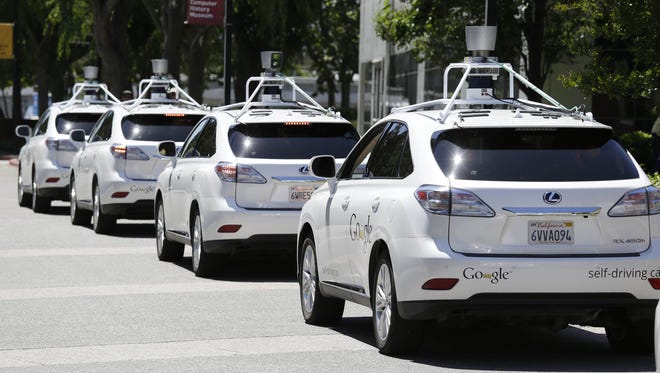Waymo's self-driving cars need less driver intervention
Google spinoff Waymo is getting closer to the day when drivers can get in a car with no pedals, steering wheel or mirrors, and allow the car to get them to their destination by simply providing the address.

How much closer? The company now reports that test drivers only have to take control about once every 5,000 miles. That's about one-fourth as often as they were required to help the cars a year ago.
Officials from the self-driving car company, a division of Google parent Alphabet, are testing their vehicles here and elsewhere in metro Phoenix.
The cars use a variety of sensors to navigate and avoid collisions.
"When the car is unsure, it does the conservative thing," said Jaime Waydo, a lead systems engineer for Waymo who has also worked in various positions as an engineer for NASA's Jet Propulsion Laboratory. "We've seen a lot of really weird stuff."
The engineers have to program the cars to not only safely navigate "weird stuff," such as a woman chasing ducks with a broom (Waydo's example), but to do it without simply bailing out and re-engaging the human driver.
Vehicle testers have had about 10 of the self-driving Lexus RX 450h vehicles in Arizona for the past nine months, along with dozens of others in Kirkland, Wash., Mountain View, Calif., and Austin. Later this month, new Chrysler Pacifica hybrid minivans will join the test fleet in Arizona.
Company officials said the number of cars in Arizona fluctuates. The cars tested Thursday had California plates.
Waydo and other company officials gave reporters rides in the vehicles around a Chandler neighborhood Thursday, explaining the technology and progress.
Since Waymo, formerly known as the Google self-driving car project, came to Chandler, General Motors has expanded its self-driving car tests to Scottsdale, and Uber brought a small fleet of similar test cars to Arizona after a dustup with California regulators.
"The fact that a lot of people are researching it shows what a large problem there is to solve," Waydo said.
The problem, as Waymo officials see it, is that 35,000 people or so die in the U.S. each year in car accidents. They believe they can make cars that drive themselves much more safely. They also envision the technology helping people such as those who are blind or otherwise incapable or operating a vehicle by providing on-call transportation.
Waymo's vehicles were involved in three accidents the first month they were in Chandler, but have not had any accidents since, Waydo said. Two cars were rear-ended, once in autonomous mode and another in manual. In the third incident, which is disputed between law enforcement and the company, the car was in manual mode and involved in a red-light running accident.

A variety of sensors distinguish the cars from the exterior, but other than a computer screen inside showing the car's interpretation of the outside world, little distinguishes it as a self-driving car other than a large, red kill-switch near the shifter.
"Every robot should have a big red button," Waydo said. "I have never heard of us using it."
Thursday was trash day, so residents near Arrowhead Meadow Park had their bins lined up in the bicycle lane. When two bins were pushed close together and near the car's lane, the vehicle slowed down and edged toward the middle of the road.
The vehicles can "see" what is going on for about 200 yards in all directions. Antennae atop the vehicles link to global-positioning system information so that the vehicles can compare what they are sensing with known information on streets, intersections and other features. But they can improvise, too, thanks to radar, which aims in all directions and provides information on other objects' speed and direction.
“Our eventual goal is to not need the driver at all," Waydo says.
Lidar, a sensing technology that uses lasers the same way radar uses radio waves, fills in a three-dimensional picture. This helps identify objects such as trees, bushes, animals, pedestrians, cyclists and other things drivers encounter on roadways that are not indicated on GPS maps.
"Lidar can tell which way a face is turned," Waydo said. "People don't usually walk backwards, though they do sometimes."
Finally, cameras atop the vehicle provide details such as color, helping identify things such as stop signs and lights.
Identifying objects helps guide the vehicles and predict whether something might wind up in their pathway or not.
Two toddlers running around in a driveway Thursday didn't seem to warrant a reaction, but a truck that had pulled more than a bumper's length out of a strip mall into the vehicle's path warranted not only braking but a brief hesitation before passing.
The ride seemed a tad jerky during some of the accelerations from stops and turns, considering some of the early reviews out of Mountain View in which people described the vehicles as overly cautious.
They wait 1.5 seconds before proceeding through a light when it turns from red to green, but otherwise Waymo officials said the technicians are trying to make them drive more like humans — but safer.
That means they must be predictable and not "drive like a robot car."
"Our eventual goal is to not need the driver at all," Waydo said.